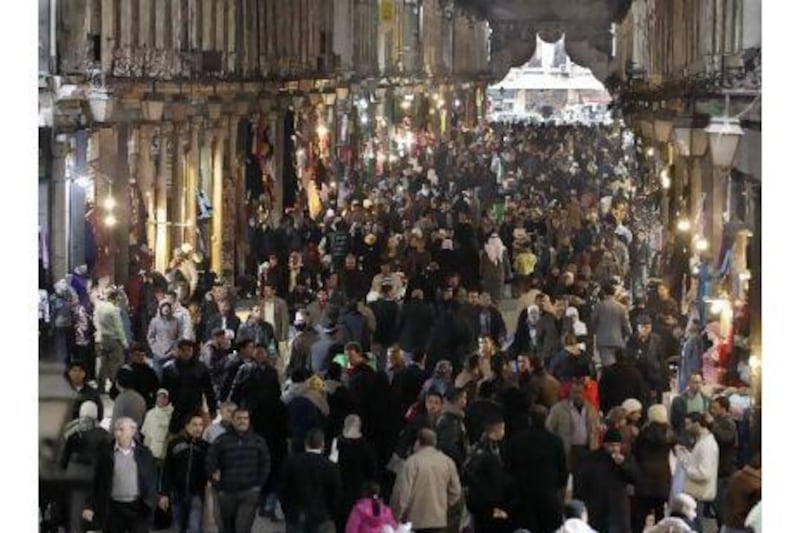DAMASCUS // In the first two months of the year, Syria's population is estimated to have grown by more than 80,000 people, and most of these extra mouths to feed have been born into the poorest, drought-ravaged eastern regions, the very areas where emergency food aid is still being handed out to malnourished families.
One of the highest population growth rates in the world - Syria is ranked ninth by the United Nations on a list of the fastest growing countries between 2005 and 2010 - is severely hampering efforts to tackle widespread poverty and raise living standards among Syria's more than 20 million citizens.
The government is putting together a strategy to slow the rate of population expansion but those plans are not expected to be drawn up before the end of this year, at the earliest, and will take years to implement or take effect.
In the meantime, development experts are warning Damascus can ill afford to wait if attempts to rein in a booming populace are to succeed.
Mohammad Akram Alkech, the dean of the Higher Institute for Population studies at Damascus University, said: "Until today there is still no clear or official policy to use family planning in order to contain the growth rate." He said such a "hands off" policy towards population growth was no longer viable.
"There have been a few laws and piecemeal measures that are supposed to stop women just being seen as machines for producing babies but that is not a comprehensive policy and will not be effective," he said.
"By the time the growth rate is reduced through that method, there will be 100 million people in Syria and it'll be too late."
Between the 1960s and 1980s, Syria's population grew at 3.8 per cent a year, a rate that saw a doubling of the populace every two decades. Damascus encouraged that expansion, viewing an increased labour force as critical to economic development, as well as providing a plentiful supply of soldiers to fight in the region's wars.
Since then the growth rate has fallen to an annual average of 2.37 per cent but, given the larger absolute numbers involved, a record 500,000 Syrians are now added to the population every year, against 300,000 when the rate of growth was at its peak.
The Syrian government convened a high-level committee in the mid-1980s to draw up a long-term population strategy but, according to officials working in the field, it was effectively mothballed for more than two decades and growth occurred without interference.
Now there is a renewed sense of urgency, with population growth continuing to far outstrip economic expansion and the ability of the country to provide jobs, schooling and food for so many extra people.
"The government does realise it has to do something about population growth, and balance it with the economic development," said an official with an international agency working on the issue in Syria.
"There have been efforts in the past to have a population policy, they had a draft, but now they are trying to revive the issue again."
Mr Alkech, who is also a board member of the government-run Commission for Family Affairs and involved in drawing up the new population strategy, said significant obstacles remained to reducing fertility rates, which are much higher in rural, agricultural areas than in Syria's urban centres. In eastern Syria, each woman typically has five or more children, compared to fewer than three per family on average in Damascus.
"There are questions of culture, social traditions and educational levels," Mr Alkech said. "And there are social taboos about limiting family size and using contraception."
Talal Taher Bakfalouni, the director of planning and international co-operation at the health ministry, said encouraging use of contraception would be a major part of the new policy.
"We currently have a shy policy in terms of contraceptives," he said. "We co-operate with the United Nations to purchase contraceptives and we distribute them to the people who want to plan their families. At the moment few families do this but gradually distribution rates are increasing."
There are signs that years of crippling drought in eastern Syria are leading some rural families to have fewer children and use contraceptives. Aid agencies working in the region say that women in some households are being encouraged to use contraceptives by their husbands, who worry they will not be able to provide for more children.
But that does not appear to be widespread, and women in rural areas say that despite significant economic hardship, their husbands borrow money in order to afford second or third wives, in keeping with a local customs that venerate men with large families.
"There are hotspots of rapid population growth in the country and we will target these with the new policies," said Mr Bakfalouni, of the health ministry. "We need to offer more job opportunities in these areas, more family planning and more education."
Even if the new policy is finalised this year, without delays, it may take another generation until the growth rate is significantly reduced because of entrenched attitudes, experts cautioned.
"A third of young people in Syria still want to get married between the ages of 15 and 19, which is quite shocking," said the international agency official. "That means girls marry young and have large families. Dealing with that will require changing attitudes and that doesn't happen quickly."





